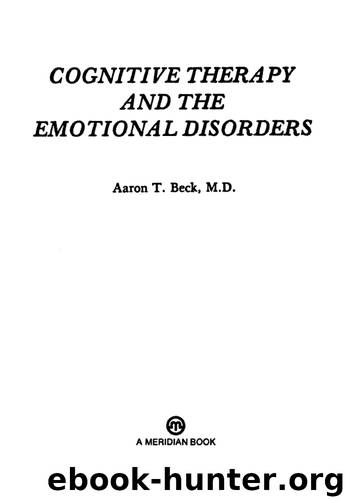Cognitive Therapy and the Emotional Disorders by Aaron T. Beck

Author:Aaron T. Beck [Beck, Aaron T.]
Language: eng
Format: epub
Tags: Cognitive Psychology & Cognition, Mental Health, Psychology
ISBN: 9781101659885
Google: nSFvAAAAQBAJ
Publisher: Penguin
Published: 1979-10-01T21:14:55+00:00
DEVELOPMENT OF PHOBIAS
There is a good deal of evidence that phobias of adults fall roughly into two groups: (1) early intense fears common to many or most children which the individual has not “outgrown.” These may be labeled “fixation phobias” to indicate that conceptual maturation with respect to this fear was arrested at an early stage in development; (2) “traumatic phobias,” similar to traumatic neuroses, in which an unusual, unpleasant or injurious experience sensitizes a person to that particular type of situation. A dramatic example of traumatic phobia is “shell shock” or fear of traveling in a car after an automobile accident.
It should be noted that the ideational content of the fears of the adult patients who come to treatment for specific phobias generally follows the distribution of fears in the population at large (or in a normal control group). As indicated by Snaith’s study of phobic patients (1968) the kind of fear reported by his patients appeared in most cases to be an accentuation of a fear experienced by numerous “normal” people in the population at large. He found, for instance, that (aside from agoraphobia) the most common fears reported by his phobic patients included fears of thunderstorms and gales, of animals, of social trauma, of illness, and of danger. The distribution of these fears among his phobic cases loosely paralleled that in his control group of normal people.
In understanding the relation between fears and phobias, it is important to emphasize the difference between the kind of fear many “normal” people experience and a phobia. First, the phobic person regards the noxious stimulus as much more dangerous than do other people. Second, because of the greater hazard that he imputes to the situation or object he experiences much greater anxiety. Third, the phobic patient has a very strong avoidance reaction and generally stays a “safe distance” from the phobic stimulus. Some patients have a “hidden phobia” which becomes manifest when circumstances prevent them from avoiding the phobic object or situation. Then the problems posed by the painful anxiety and the restrictions on his life lead the phobic to seek help.
Early childhood fears tend to center on the danger of physical injury or death. These fears frequently persist throughout life. In addition, older children show concern about social injury, such as rejection (Berecz, 1968).
The mothers of children ranging in age from twenty-three months to six years reported that what their children feared most were (in order of frequency) dogs, doctors, storms, deep water, and darkness. Significantly, there was an obvious tendency for the content of the child’s fears to correspond to those of the mother. Moreover, there was a substantial correlation between the total number of children’s fears and the total number of their mothers’ fears. This suggests a familial pattern—a point we shall come back to when we consider “fixation phobias.”
Direct interview (Jersild, Markey, and Jersild, 1960) of 398 children aged five to twelve determined the frequency of fears as follows: supernatural agents (ghosts, witches, corpses, mysterious events)—19.2%; being
Download
This site does not store any files on its server. We only index and link to content provided by other sites. Please contact the content providers to delete copyright contents if any and email us, we'll remove relevant links or contents immediately.
Rewire Your Anxious Brain by Catherine M. Pittman(18491)
Talking to Strangers by Malcolm Gladwell(13135)
The Art of Thinking Clearly by Rolf Dobelli(10142)
Mindhunter: Inside the FBI's Elite Serial Crime Unit by John E. Douglas & Mark Olshaker(9107)
Becoming Supernatural by Dr. Joe Dispenza(8040)
Change Your Questions, Change Your Life by Marilee Adams(7567)
The Road Less Traveled by M. Scott Peck(7475)
Nudge - Improving Decisions about Health, Wealth, and Happiness by Thaler Sunstein(7461)
The Lost Art of Listening by Michael P. Nichols(7360)
Mastermind: How to Think Like Sherlock Holmes by Maria Konnikova(7164)
Enlightenment Now: The Case for Reason, Science, Humanism, and Progress by Steven Pinker(7085)
Win Bigly by Scott Adams(7033)
The Way of Zen by Alan W. Watts(6452)
Daring Greatly by Brene Brown(6369)
Big Magic: Creative Living Beyond Fear by Elizabeth Gilbert(5557)
Grit by Angela Duckworth(5449)
Ego Is the Enemy by Ryan Holiday(5228)
Men In Love by Nancy Friday(5115)
Altered Sensations by David Pantalony(5006)
